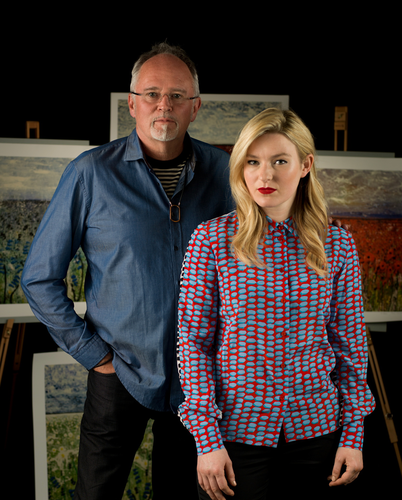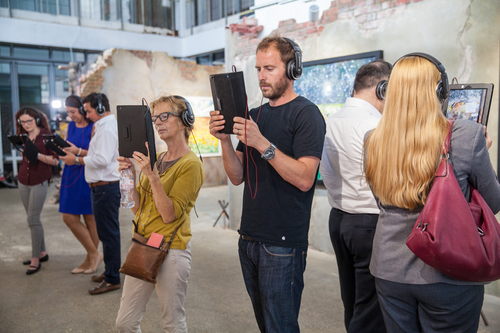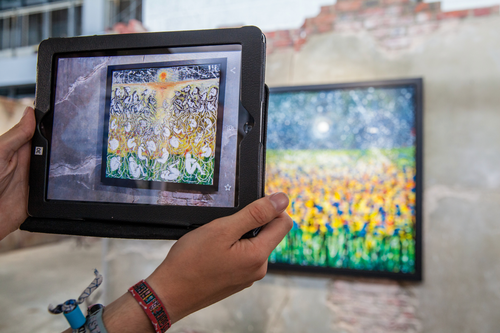by Carolyn Edlund
Artist Scarlett Raven and producer Marc Marot use cutting edge technology to embed works of art with an experiential element that brings a story to life.

British team Marc Marot and Scarlett Raven create an unusual augmented reality experience.
Calling themselves “Augmentists”, Raven and Marot are an independent partnership who have worked together to produce more than 20 paintings, based on the World War I Battle of the Somme. They present the work in a unique exhibition entitled “The Danger Tree”.
Each oil painting is built up by Raven in many layers using stop motion animation techniques. She has a camera on the ceiling and a canvas on the floor and each daub of paint is captured and turned into animation. Once she’s turned the work over, Marot adds layers of animation, including photography, footage, bespoke music and poetry creating a multi-media story.
When the painting is viewed through a smartphone or tablet using the Blippar App, the layers are unlocked, telling the story behind the painting, and the history of the war. The paintings are enhanced by poetry performances by some of the UK’s most formidable acting talent including Sean Bean, Christopher Eccleston and Gemma Arterton. The poems include works by Wilfred Owen, Siegfried Sassoon and John McRae.
Creating each painting is a minimum two-week long endeavor, and starts with a storyboard. Every stroke of paint is individually photographed, which allows a stop-motion film to be made. Marot says, “Scarlett adds the paint. I do the pixels and production.” Since each augmented painting is produced like a movie, creating it is not sequential. In fact, Raven typically works on ten different paintings at a time.
Launching their collaborative work in Greenwich, England in 2016, Raven and Marot produced an augmented reality art exhibition titled “The Danger Tree” that commemorated the 100th anniversary of the Battle of the Somme. Rather than hang the works in a typical gallery setting, they chose an unused retail space, and commissioned set designer Kave Quinn to construct an environment that looked like a bombed out art gallery in Picardy France, on the eve of the Battle of the Somme to hold the artwork.

Visitors entering the exhibition were handed a tablet and headphones, through which they viewed each painting and experienced the story within the layers. Prints of the paintings were available at the event, each of which also shows the layers of media when viewed using the Blippar app, and they sold out quickly.
How did this astonishing project start, and where is it going? I interviewed Raven and Marot about their innovative idea, and the results they have achieved.
AS: What was the inspiration for each of you to become involved in this project?
Scarlett: My father Raphael Ravenscroft was a successful musician. In the course of his work, he created the music for project in celebration of the symbolism of the poppy. This in turn led to my interest. I began to explore the subject in paintings just prior to teaming up with Marc. I approached him to see if he would consider creating a partnership with me and we began to look around for areas of mutual interest.
Marc: Both Scarlett and I arrived at the subject from different avenues. The First World War subject was perfect for me because my grandfather (through marriage) was a veteran of the First World War. His name was Eddie Bigwood, and he was born in 1898 and died 100 years later. He joined up, age 18, in 1916. After a period of training, he was sent out to the battlefields of northern France. At Ypres a shell exploded some 10 feet away from him. A piece of red hot shrapnel took much of his bottom jaw and his right ear.
He was sent home to the UK for convalescence, and after a period of three months, he was sent back again to carry on the fight. He could scarcely hear the orders he was being given as he was profoundly deaf by this time.
He chose me to be his confident in his mid-eighties. He’d not spoken about the war until then, and he would tell me incredibly emotional stories that made him weep. Eddie was my hero. This made it a very fitting subject matter for me.

Augmented Reality viewed through a tablet
AS: How does the audience react to an augmented reality art exhibition?
Scarlett: We first tested the work by taking it to a private viewing held by our UK art distribution partners Castle Fine Art. We hung two works within a multi-artist exposition, and then shared the work with the 200 or so Castle Fine Art sales staff who were in attendance. By the end of the day we noted that we’d made 26 people cry when viewing the work. We’d not shared any of it with anyone until that point, and that first reaction was a real eye-opener for the both of us. By that stage we’d completed six works, and we began sharing those amongst our close team and realised that we were on to something special: the work stirred really strong emotions in everyone.
Marc: We decided to stage the exhibition in an unusual way, by building a set just like a Hollywood movie. When you enter the exhibition, you enter a destroyed, burnt down place. It sets the tone for the work. The viewer is given an iPad and headphones, and you are then separated from whoever you came in with so viewing the work becomes rather personal which tends to take people into a slightly different zone mentally.
When confronted with deeply emotional poetry, performed by potent (and often angry) actors as well as the animation and the music, the reaction is almost universal: tears.
35,000 people have now visited the three exhibitions we held so far, and we have thousands of written entries in our visitors books all of which tend to say the same things; the exhibition is unique, the exhibition is moving, and the exhibition is truly original.
Scarlett: Neither of us can imagine a more perfect reaction for two artists to receive. Marc and I are both truly humbled by it. We’ve sold all 22 Danger Tree original oil paintings as well as over 3,000 prints so far, so something is working well emotionally for that to happen.
AS: What are your plans for future projects, where will you exhibit them?
Scarlett: After two years of creating work for the Danger Tree project, we are slightly afraid that will become typecast as war artists. Having said that, both of us feel very strongly that we have tapped into an emotional subject that we both understand, and it would be a shame just to let that go too easily. The 100th anniversary of the end of the conflict falls on November 11th next year, so in the meantime we will be following it to its logical conclusion. We’ve held three UK exhibitions so far, and have another four major city exhibits booked, taking us until the end of 2018.
Marc: We are currently looking for opportunities in North America, so we have appointed a manager to start the process. For the US launch, we intend to build a parallel burnt down film set, and bring 15 new paintings over which will include new works which specifically enshrine stories pertinent to America. The US had over 1 million soldiers on French soil by the end of the First World War. Over 165,000 Americans were killed or wounded. It truly was a world war, and there are plenty of stories that we have yet to tell.
Both: In the longer term? There are so many subjects that interest us that we feel no fear of the future. We’ll not be revealing our next project quite yet, however count on it being an emotional subject!


fascinating process, thanks for sharing
The production aspects of this art form are astonishing. I applaud their commitment, sensitivity and ability to share.
Hi Sharon…. Scarlett and I are in the middle of delivering our 4th major exhibition…. so right now I find myself somewhat cursing the production aspects!! In reality it’s a very rewarding labour of love for us. Marc Marot
Wow…this process is a very inspiring marriage of concept and technology. As a painter who has always been in love with layers, this is a visual delight. Much like theater. Bravo!
Hi Linda…. many thanks for the positive feedback! We love the work and even though it is sometimes really dark in material it’s always uplifting for us to create. Marc